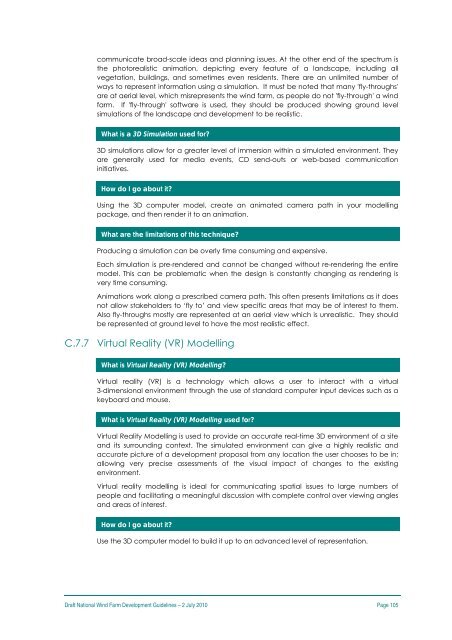Draft National Wind Farm Development Guidelines - July 2010
Draft National Wind Farm Development Guidelines - July 2010
Draft National Wind Farm Development Guidelines - July 2010
You also want an ePaper? Increase the reach of your titles
YUMPU automatically turns print PDFs into web optimized ePapers that Google loves.
communicate broad-scale ideas and planning issues. At the other end of the spectrum is<br />
the photorealistic animation, depicting every feature of a landscape, including all<br />
vegetation, buildings, and sometimes even residents. There are an unlimited number of<br />
ways to represent information using a simulation. It must be noted that many 'fly-throughs'<br />
are at aerial level, which misrepresents the wind farm, as people do not 'fly-through' a wind<br />
farm. If 'fly-through' software is used, they should be produced showing ground level<br />
simulations of the landscape and development to be realistic.<br />
What is a 3D Simulation used for<br />
3D simulations allow for a greater level of immersion within a simulated environment. They<br />
are generally used for media events, CD send-outs or web-based communication<br />
initiatives.<br />
How do I go about it<br />
Using the 3D computer model, create an animated camera path in your modelling<br />
package, and then render it to an animation.<br />
What are the limitations of this technique<br />
Producing a simulation can be overly time consuming and expensive.<br />
Each simulation is pre-rendered and cannot be changed without re-rendering the entire<br />
model. This can be problematic when the design is constantly changing as rendering is<br />
very time consuming.<br />
Animations work along a prescribed camera path. This often presents limitations as it does<br />
not allow stakeholders to ‘fly to’ and view specific areas that may be of interest to them.<br />
Also fly-throughs mostly are represented at an aerial view which is unrealistic. They should<br />
be represented at ground level to have the most realistic effect.<br />
C.7.7 Virtual Reality (VR) Modelling<br />
What is Virtual Reality (VR) Modelling<br />
Virtual reality (VR) is a technology which allows a user to interact with a virtual<br />
3-dimensional environment through the use of standard computer input devices such as a<br />
keyboard and mouse.<br />
What is Virtual Reality (VR) Modelling used for<br />
Virtual Reality Modelling is used to provide an accurate real-time 3D environment of a site<br />
and its surrounding context. The simulated environment can give a highly realistic and<br />
accurate picture of a development proposal from any location the user chooses to be in;<br />
allowing very precise assessments of the visual impact of changes to the existing<br />
environment.<br />
Virtual reality modelling is ideal for communicating spatial issues to large numbers of<br />
people and facilitating a meaningful discussion with complete control over viewing angles<br />
and areas of interest.<br />
How do I go about it<br />
Use the 3D computer model to build it up to an advanced level of representation.<br />
<strong>Draft</strong> <strong>National</strong> <strong>Wind</strong> <strong>Farm</strong> <strong>Development</strong> <strong>Guidelines</strong> – 2 <strong>July</strong> <strong>2010</strong> Page 105
















